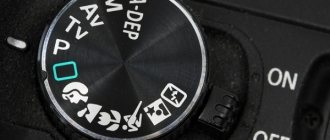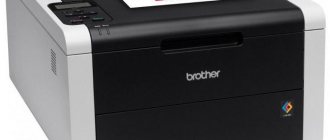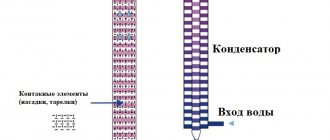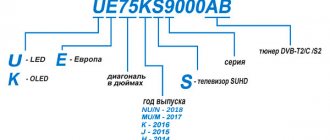Let's figure out what is the difference between a DSLR camera and a mirrorless one.
After all, just a few years ago, SLR cameras were the only choice for those who were planning to take photography seriously.
But now they have a strong competitor - mirrorless cameras. So what is the difference between a DSLR and a mirrorless camera?
The difference between a DSLR and a mirrorless camera
On the left is a DSLR camera. On the right is a mirrorless camera.
It’s not hard to guess that the most important difference between a DSLR camera and a mirrorless one is the mirror. If you remove the lens from a DSLR camera, you can see the mirror behind it.
To be very precise, a system of mirrors. With which we can see the image in the viewfinder.
When we take a picture, the mirror rises and light hits the camera sensor, creating a photograph.
A mirrorless camera has a sensor directly behind the lens. And in the viewfinder we see an electronic image that has already been processed by the camera.
Differences in the design of compacts and DSLRs
DSLR or compact? In addition to the obvious differences in operating principles, a DSLR camera differs from a regular compact camera in focusing functionality. A SLR camera has an optical focus, as optics work - a system of mirrors and lenses. Compacts are electronic; the focus is monitored by a processor. This is why compacts are often popularly called “point-and-shoots,” because due to the automatic focus, the processor sometimes likes to “blur” images, making them unclear.
Besides this, there are a few other differences:
- Lenses. Compacts do not have a mirror system, but their lens can be much better than a regular kit lens on a DSLR. This lens is called “ultrazoom”. It allows you to shoot any objects at a fairly good zoom, for example, 40,50 or even 60 times.
- Additional funds. Digital or DSLR? Sometimes a photographer needs additional tools, such as a flash or an off-camera microphone. You can’t connect such things to a lightweight compact. And the battery won’t last, because a DSLR camera lasts much longer.
- Charger. Is it better to have a mirror or a system compact? The compact, relatively speaking, has enough battery power for 200-300 shots, if no one drains the battery and looks at the results of the shots on the display. And the display itself is smaller and much worse; it is grainier than that of mirror models.
- Matrix size. It seems that this is not a critical parameter, but it means that the larger the matrix, the correspondingly more light it will collect upon itself when the shutter is released. And the quality of the final picture increases based on the amount of light collected. Which matrix is better? Now the most popular is the full-size 24*36 mm matrix, which can be found in expensive SLR models. The matrix of compacts can be 13*18 to 22.7*15 mm, which also allows you to take acceptable photographs. For comparison, even the most expensive non-mirror compacts cannot have a matrix larger than 8*6 mm, and sometimes it can be smaller.
- Lens material. In addition to the lack of mirror optics, compacts also suffer from the material of the lens system itself. The DSLRs have them made of glass, while the compact ones have plastic ones.
- Price. This is also where a DSLR differs from a digital camera. The price of non-DSLR cameras can be equal to a quarter of the cost of a DSLR camera. Good models start from 5,000 rubles, and the price of SLR cameras starts from 25,000 rubles for standard equipment (body plus lens).
Dimensions
Since mirrorless cameras do not have a mirror unit, they are more compact and lightweight. Here everyone decides for themselves whether to shoot with a large camera and look like a professional, or choose a smaller camera.
On the left is a mirrorless camera. On the right is a DSLR camera.
But don't forget that SLR cameras are becoming more compact and lighter. And mirrorless cameras are acquiring new capabilities and inevitably getting larger. But for now there is still a difference between them.
What to do about it
- Well, I told you everything - so what? Here are a few life hacks - briefly and using now familiar terms. Watch your aperture. Now you know what an aperture is and that its width can be adjusted - the larger the value near the letter F, the smaller the aperture width.
A wide open aperture is suitable, for example, for portraits - when the face should be the center of attention and the background should be soft. If you are shooting something landscape, where everything is supposed to be more or less sharp, the aperture needs to be narrower.
- Remember endurance. And we are not talking about the psychological difficulties that a beginning photographer faces. Shutter speed is, roughly speaking, the time for which the shutter is closed. It is easy to find it on the display - it looks like a fraction (1/30 seconds, for example).
The longer the shutter speed, the more blurry the pictures may turn out - so if you are not photographing a sporting event or do not want to capture the flight of a meteorite, choose a short one - 1/50, 1/60 seconds are suitable for normal conditions.
- What's hidden in the display. In addition to all the useful settings that we have already talked about (or haven’t yet), the display can be very useful. For example, you can set up a “grid” there - auxiliary lines that will help you not to block the horizon or find that very golden ratio.
Viewfinder
In mirrorless cameras, manufacturers have removed the mirror block and replaced it with an electronic viewfinder. What's better? The question is ambiguous. On a mirrorless camera, in the viewfinder you immediately see the frame as the camera sees it. By changing the shutter speed and aperture, the result is immediately visible. This is very useful for beginner photographers.
With an optical viewfinder, things are much more complicated. Through it we see the world as our eyes see it. You only have to rely on the built-in exposure meter. But it has a number of advantages.
It does not delay when shooting moving objects. And under poor conditions, it provides better light and color rendition.
Camera matrix
The matrix is the heart of a modern camera. The quality of the photographs will largely depend on its quality. The matrix has two main characteristics, information about which is available to the consumer: resolution and physical size.
First let's deal with resolution. The resolution of a matrix is the number of its photosensitive elements, pixels. The more there are, the more points will make up the final photo. Today, the average resolution of matrices is from 16 to 36 million pixels.
However, it may be that there are a lot of megapixels on the matrix, but the quality of the image is still low: it is not sharp, lacks contrast, and is buried in digital noise - interference. Image quality depends not only on the resolution in megapixels, but also on the physical size of the matrix itself.
A fragment of a photo taken on a smartphone with an 8 megapixel camera
A fragment of a frame with a resolution of 8 megapixels, taken on a SLR camera.
Both pictures were taken at the same resolution. As you can see, the frame taken on a mobile phone is much inferior in quality: it is not as contrasty, and small details, for example, the veins on a leaf, are not preserved in the picture. But it is precisely the small details that the high resolution of the matrix should be responsible for.
Different types of cameras are equipped with matrices of different sizes. The largest one in this diagram is a full-frame sensor. Its size corresponds to a frame from the familiar “135” or simply “35 mm” film format - 36x24 mm. Matrices of this size allow you to obtain very high quality images. But the larger the physical size of the matrix, the more expensive it is. Therefore, large matrices are found only in fairly expensive devices. APS-C format is typical for amateur DSLRs. The cheaper the device, the smaller the matrix installed in it.
Large matrices provide benefits not only in detail, but also in image quality when shooting at high sensitivity values in poor lighting. The fact is that on a large-area sensor it is possible to implement a larger size of the light-sensitive elements themselves - pixels. For comparison: one photosensitive element of the matrix of a modern full-frame camera has an average size of 4.9-8.3 microns. The size of one pixel in a compact camera or smartphone is about 1-3 microns.
Autofocus
Here the advantage is still on the side of SLR cameras. Mirrorless cameras, due to the lack of a mirror block, use less technically advanced contrast autofocus. It focuses slower and not as accurately as a DSLR.
Technologies do not stand still and the autofocus of mirrorless cameras is already very close to the autofocus of SLR cameras. Therefore, it is impossible to give an absolute advantage to DSLRs.
Functionality of compacts and DSLRs
Compact fans always argue with DSLR fans about functionality. What is the difference? Here it is important to consider the main thing - for what purpose does a person take photographic equipment? If you need a simple device that works on the principle: “click” - “here is a photo,” then a compact is the best option.
No need to bother with settings, know the basics of photography, etc. For a point-and-shoot camera, the most important thing is to capture the desired frame with little loss. Yes, the image may have noise and may be slightly blurred, but this is not critical, however, a photo for memory is taken extremely quickly. You can quickly zoom in or out on an object, as well as use several filters after shooting with the camera.
So, SLR and digital...
DSLR models are much more than just a camera. It is no coincidence that the camera is called a SLR, that is, the best reflector. These cameras offer a lot more room for experimentation than digital ones, especially in manual mode. Changing the focus, changing the shutter speed, adjusting the aperture time is easy!
Only for this you need to understand the instructions well and learn the basics of photography. For beginners, there is on-site practice - an automatic mode that will help you learn everything in the field.
Thanks to better focusing, the DSLR camera offers clear continuous shooting and panoramas without loss of quality. And, of course, color rendering... DSLR cameras even have interchangeable filters to play with color and make the end result a real work of art.
Lenses
Lenses for DSLRs and mirrorless cameras require different lenses. Modern SLR cameras have a longer history, so many more lenses have been invented for them.
Lenses for mirrorless cameras benefit from compactness, but there is less choice and they are more expensive.
But there is a solution to this problem. All manufacturers have adapters that allow you to use lenses from SLR cameras.
Optical mount
Digital cameras often have interchangeable lenses. If your camera is like this, pay attention to how the optics are attached to the camera device. This can make a big difference, especially if you plan to use massive lenses.
There are two main mounts:
1. Threaded fastening. With this connection, both the camera and the lens have a thread. They are fastened by normal twisting and unfastened by reverse untwisting.
This mount has been popular since the advent of film cameras. In modern devices this type of connection is almost never used.
Threaded fastening has a number of disadvantages:
- It takes time to install the lens. Sometimes it is not possible to tighten it the first time; in some cameras you have to make several turns.
- If the lens is not fully screwed in, it may unscrew itself over time, resulting in loss of image sharpness.
- Due to constant friction, small metal particles may appear that can get into the matrix. In this case, of course, you will have to clean it.
There is an important advantage of a threaded connection - it is cheaper to manufacture.
2. Bayonet mount . With this connection, you need to insert the optics and scroll clockwise until it clicks. To unfasten, you need to press a special button near the lens and scroll in the opposite direction.
This mount allows you to quickly change lenses and securely connect them to the camera. In addition, the opportunity has opened up to use electronic optics, where many contacts are connected.
This connection has practically no disadvantages, but a new problem has appeared. Most manufacturers produce lenses specifically for their cameras. This marketing ploy is understandable, but it limits the choice of optics. Of course, in this case it is better to buy a lens from your own manufacturer. There are manufacturers that produce lenses compatible with similar cameras, but their quality is noticeably worse.
Battery life
Here DSLRs have a complete advantage. Due to the use of a mechanical mirror unit. Using the electronic viewfinder and display requires constant power consumption.
In addition, the more compact sizes of mirrorless cameras require smaller batteries. This leads to the next disadvantage - lower capacity. Therefore, it is better to stock up on spare batteries.
Eventually
Just a few years ago, mirrorless cameras could not compete with DSLR cameras either in image quality or shooting capabilities. But today they are largely equal. There are pros and cons to each class of camera.
Brief description of other parts of photographic equipment
The presence of a flash allows you to highlight objects located in the foreground close to the photographer. Typically, such devices, which are initially built-in, are characterized by low power. For this reason, semi-professional and professional photographic cameras are equipped with a connector that allows you to connect additional flash units.
The camera's functions are enhanced by the use of flashes that can reduce red-eye. It is also convenient to have several basic operating modes:
- automatic;
- forced;
- slow sync;
- no flash.
To take self-portraits or eliminate camera shake, use a self-timer. This device creates a time delay between when you press the shutter and when it actually fires.
On a note! During long-term photography, it is recommended to power a number of DSLR models instead of rechargeable batteries using an adapter connected via the DC IN connector. This is only possible if you have access to a 220 V network.
The camera processor performs the following functions:
- controls the flash, camera interface, autofocus;
- calculates exposure;
- processes data from the matrix;
- adjusts sharpness, photosensitivity, contrast, white balance, noise and a number of other picture parameters;
- saves the image on the memory card, compressing the files;
- provides communication with external devices (for example, a computer).
When digital data is processed by the processor, it is stored in RAM. To permanently save information, removable media are used in the form of memory cards of different formats (for example, SecureDigital - SD).
Thanks to the presence of control buttons, you can manually control various settings, for example: adjust the shutter speed with aperture, set the light sensitivity of the matrix, white balance. This allows you to control the entire photography process and create the required effects.
Conclusion
We briefly looked at the design of various types of cameras. I think now you have a general idea of the internal structure of cameras. This topic is very broad, but to understand and control the processes that occur when shooting with certain cameras at different settings and with different optics, I think the above information will be enough. In the future, we will still talk about some of the most important elements: the matrix, autofocus systems and lenses. For now, let's leave it at that.
Something is wrong with the review. Where is Nikon, where is Canon?
Everything is correct.
These giants have not gone away, but they have no equal in the field of “big” professional photography. And in the niche of amateur “small-sized” photography, alas, smaller players rule the roost. However, if you want a larger camera, then I would recommend taking a closer look at the Nikon D3300. This is an entry-level DSLR that allows you to join the world of big photography. At the same time, I would recommend considering the Nikon 35mm F / 1.8G AF-S DX prime as the first additional lens
In general, this is a rather funny nuance. As a rule, the first thing most novice photographers buy is a zoom lens, not realizing that most scenes within the city or in nature require either a wide-angle (so that everything necessary is included in the frame) or a prime lens (to capture everything as the human eye sees) .
Actually, that’s why I always advise you to take a closer look at the fix first. As Andy Hendrickson of the Phoblographer blog writes: “You could weld this lens onto my Nikon D7000 and I wouldn't complain. This is one of Nikon's cheapest lenses and one of my favorites. It has a surprisingly versatile focal length and is fast enough for handheld shooting in low light.”
If you want to understand what is closer to you, you can go to the simulator developed by Nikon and see how optical zoom numbers affect the image.
Nikon D3300, again, is an entry-level camera. While DSLRs definitely begin to outperform mirrorless cameras somewhere at the price level of $1000-1500 per device. And here I would advise you to look at the Nikon D7200 or Canon EOS 70D.
On the other hand, if you know why you need such a device, you are unlikely to read this text 
Afterword from iCover:
Dear readers, we remind you that you are reading the iCover company blog, a place where you can get good advice or expertise in the world of gadgets. And, of course, don’t forget to subscribe to us and we promise you won’t be bored!











